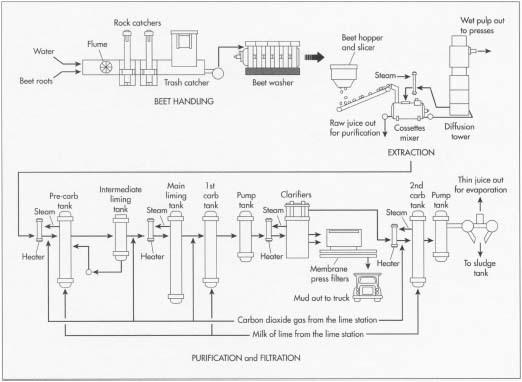Molasses
Molasses, from the Latin word melaceres, meaning honey-like, is a thick dark syrup that is a byproduct of sugar refining. It results when sugar is crystallized out of sugar cane or sugar beet juice. Molasses is sold both for human consumption, to be used in baking, and in the brewing of ale and distillation of rum, and as an ingredient in animal feed.
History
The pressing of cane to produce cane juice and then boiling the juice until it crystallized was developed in India as early as 500 B.C. However, it was slow to move to the rest of the world. In the Middle Ages, Arab invaders brought the process to Spain. A century or so later, Christopher Columbus brought sugar cane to the West Indies. Another two hundred years later, cuttings were planted in New Orleans.
Molasses figured prominently in the infamous slave trade triangles of the late seventeenth century. English rum was sold to African slave traders who brought slaves to the West Indies and then brought West Indian molasses back to England.
Using sugar beets to produce sugar was not developed until the mid-1700s when a German chemist Andreas Marggraf discovered the presence of sugar in the vegetable. By 1793, another German chemist, Franz Karl Achard, perfected the process for extracting the sugar from the beets.
The first beet sugar factory opened in Prussian province of Silesia in 1802. During the Napoleonic Wars, the British blockaded France, cutting off French access to sugar imports from the West Indies. Napoleon then issued land grants and large sums of money to encourage the establishment of a beet sugar industry. One man who took Napoleon up on his offer was a French banker named Benjamin Delessert. Delessert set up several beet sugar factories at Passy and within two years produced four million kilos of sugar. For his efforts, Napoleon awarded Delessert with the medal of the Legion of Honor. By the end of 1813, 334 French sugar beet plantations were producing 35,000 tons of sugar.
In contrast, the beet sugar industry struggled in the United States until the end of the nineteenth century when a California factory finally turned a profit. At the turn of the century, the country had 30 beet sugar processing plants.
Molasses figured prominently in two peculiar events in United States history. The first was the Molasses Act of 1733, which imposed duties on all sugar and molasses brought into North American colonies from non-British possessions. The second was the Great Boston Molasses Flood of January 1919 when a molasses storage tank owned by the Purity Distilling Company burst, sending a two-story-high wave of molasses through the streets of the North End of Boston.
Before the advent of harvesting machinery, laborers performed the back-breaking work of cutting and stripping the sugarcane by hand. Mule-driven mills pressed the sugar cane to release the syrup, which was then cooked in large kettles over a fire until thickened. Workers, usually the farmer's

Boston's inner harbor was memorialized on January 15, 1919, by one of the most bizarre structural failures ever to occur anywhere. On that mild winter day, without warning, a massive tidal wave of nearly 12,000 tons of thick, brown, sugary molasses gushed from a fractured steel tank, leaving twenty-one dead, over one hundred and fifty injured, and many buildings crushed under.
The huge 50 ft (15.2 m) high, 90 ft (27.4 m) diameter steel tank had been used by the U.S. Industrial Alcohol Company for storing up to 15,000 tons of molasses. The tank was ordered from Hammond Iron Works in 1915 by the Purity Distilling Company on authorization of U.S. Industrial Alcohol. The treasurer of Purity ordered it without consulting an engineer. The only requirement used in making the order was that the tank have a factor of safety of three for the storage of molasses weighing 12 lb per gal (5.4 kg per l) (50% heavier than water).
All the steel sheets used in construction of the tank actually proved less thick than shown on the drawings used to obtain the building permit. For instance, the bottom ring—the most stressed part of the structure—was supposed to be 0.687 in (1.74 cm); in actuality it was only 0.667 in (1.7 cm). The steel thicknesses for the other six rings were like-wise 5-10 percent less than shown on the permit plans. The bottom ring (ring one) had a 21 in (53.3 cm) diameter man-hole opening cut out of it.
The tank was completed early in 1916 and tested only by running six inches of water into it. On a dozen occasions during the tank's three years of service it contained a maximum of around 1.9 million gallons (for periods up to twentyfive days). The content that dark day in January was some 2.3 million gal (8.7 million l)—near capacity. It had been in the tank for four days. Months later, at the legal proceedings, several recalled that the seams of the tank were leaking molasses, but no one seemed to be concerned
It was 12:40 P.M. when eyewitnesses said they heard sounds like machine-gun fire and then saw a torrent of molasses, two stories high, exploding out over adjoining property. Six children were immediately swallowed up.
The tank had fractured and burst open. A 2.5-ton section of the lower part of the tank was thrust out onto a playground 182 ft (55.5 m) away. Another section of the structure wrapped itself around and completely sheared off one column of an adjacent elevated railway. Traveling at about 35 mi (56.3 km) per hour, the molasses swept over and through everything in its path. At its most destructive moments, the gooey wave was 15 ft (4.6 m) high and 160 ft (49 m) wide.
People and animals lost their lives either by drowning or by being struck by wreckage. Occupied houses were demolished, while the cellars of others were filled with molasses. Rescue crews found one man and his wagon embedded in a mountain of molasses, man and horse both frozen in motion.
By midafternoon the flood had settled. It covered more than a two-block area and the general vicinity looked like it had been hit by a cyclone. Buildings were destroyed or bull-dozed off their foundations, rails from the elevated railway were dangling in the air, and the tank itself lay on the ground, a heap of crumbled junk metal.
Police and firemen used huge hydraulic siphons around the clock to pump molasses out of flooded cellars. It was nearly a week before all the bodies were recovered and months before signs of the disaster disappeared.

wife and children, poured the syrup into cans and covered them. The cans were loaded onto a platform and cooled by an overhead fan.
Raw Materials
Sugar cane or sugar beets are the primary ingredient for the sugar process of which molasses is a byproduct. Sugar cane (Saccharum officenarum) is a tall thick perennial that thrives in tropical and subtropical regions. It can grow to heights range from 10-26 ft (3.05-7.9 m), and measuring 1-2 in (2.54-5.08 cm) in diameter. Colors range from white to yellow to green to purple. The Everglades of south Florida are a major producer of sugar cane with 425,000 acres grown annually that yields 90 million gallons of black strap molasses. At harvest time, the stalks are stripped of their leaves and trimmed.
Sugar beets (Beta vulgaris) can tolerate more temperate or colder climates than sugar cane. Therefore, the choices of growing areas is greater. At the end of the twentieth century, the leading sugar beet producers were Russia, France, the United States, and West Germany. The sugar is contained in the vegetable's root, approximately 15 teaspoons per beet root. At harvest, the tops are removed and used for cattle feed.
Milk of lime is used in the clarification process. Essentially burnt lime, it is produced in the factory by heating lime rock in a kiln. The lime rock is then mixed with sweet water—a byproduct of a previous clarification process.
Carbon dioxide is released in the lime milk process. It is purified in tanks and also used in to clarify the sugar juice.
The Manufacturing
Process
Whether the base is sugar cane or beets, the sugar extraction and refining process of which molasses is a byproduct is a circular path of washing and heating the cane and beets with hot water.
Washing and cutting
-
1 The sugar cane stalks are loaded onto conveyer belts and subjected to
hot water sprays to remove dirt and other field debris. Then, they are
passed under rotating knife blades that cut the stalk into short pieces
or shreds.
Beet roots are loaded into a tunnel-like machine called a flume, in which leaves, weeds, and rocks are separated out. A pump pushes the beets into a washer fitted with a large shaft that moves the beets through the water to remove any remaining dirt. The beets move through a slicer that cuts the beet roots into thin strips called cossettes.
Extracting the sugar juice
-
2 In the sugar cane processing plant, extraction can be accomplished in
one of two ways: diffusion or milling. By the diffusion method, the cut
stalks are dissolved in hot water or lime juice. In the milling process,
the stalks are passed under several successive heavy rollers, which
squeeze the juice out of the cane pulps. Water is sprayed throughout the
process to facilitate the dissolving of the juice.
In the sugar beet factory, the sliced beet roots, or cossettes, are loaded into cylindrical diffusers that wash the beet juice out with the aid of hot water. The discarded beet juice is used to pre-scald cossettes in the mixer so that they absorb even more of the sugar.
Clarifying the juice
- 3 The extracted juice is clarified by adding milk of lime and carbon dioxide. The juice is piped into a decanter, heated and mixed with lime. The juice passes through carbon filters, producing a mud-like substance. Called carb juice, this mud is pumped through a heater and then to a clarifying machine. Here the mud settles to the bottom and the clear juice is piped to yet another heater and treated again with carbon dioxide. Once again the mud is filtered out, leaving a pale yellow liquid called thin juice.
Evaporating and concentrating the syrup
- 4 The juice is pumped into an evaporator that boils the juice until the water dissipates and the syrup remains. The syrup is concentrated through several stages of vacuum boiling, a low temperature boil to avoid scorching the syrup. Eventually, the sugar crystallizes out of the syrup, creating a substance called massecuite. The massecuite is poured into a centrifuge to further separate the raw sugar crystals from the syrup. In the centrifuge, the sugar crystals fall away from the syrup that is being spun at a significant force. This remaining syrup is molasses, and it is forced out through holes in the centrifuge.
Storage and boffling
- 5 The molasses is piped to large storage tanks. It is then pumped, as needed, to the bottling machine where pre-measured amounts of molasses are poured into bottles moving along a conveyer belt.
Byproducts/Waste
In addition to molasses, which is itself a byproduct of the processing of sugar cane, there are several others materials that are used for other purposes. After pressing the juice out of the cane stalks, the dry stalk residue, called bagasse, are used as fuel in the plant. Beet pulp is used in the processing of pet foods. Cane wax, which is extracted from the dry residue, is used in the manufacture of cosmetics, polish, and paper coatings.
Where to Learn More
Periodicals
"Sugarcane and the Everglades." Journal of the American Society of Sugar Cane Technologists (1997): 9-12.
Other
Florida Crystals. http://www.floridacrystals.com/ .
Monitor Sugar Company. http://www.monitorsugar.com/htmtext .
Steen' s. http://www.steensyrup.com .
— Mary McNulty
Comment about this article, ask questions, or add new information about this topic: